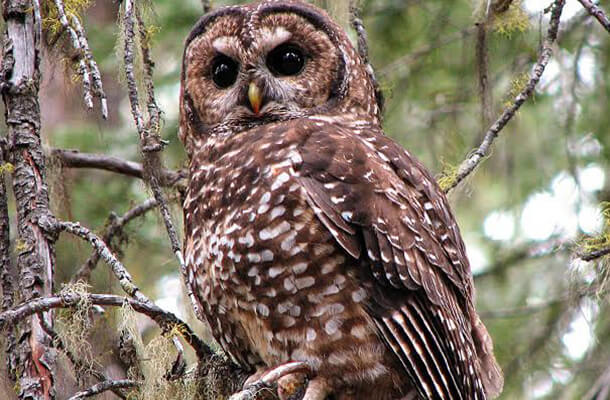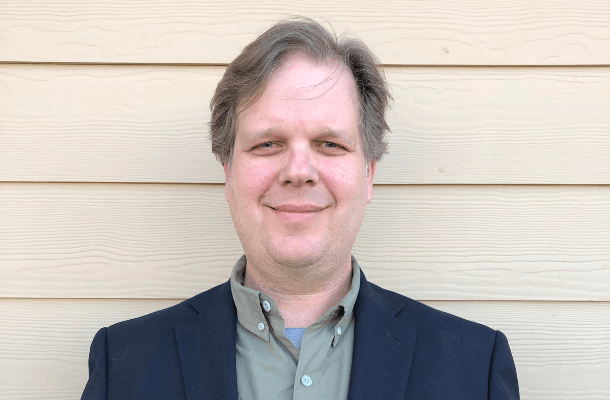Plan to Shrink National Monuments Jeopardizes Habitat for Threatened Birds
Contact: Steve Holmer, Vice President of Policy, 202-888-7490, or Jennifer Howard, Director of Public Relations, 202-888-7472
(Washington, D.C., Sept. 8, 2017) The Interior Department review of National Monument designations has produced recommendations that, if enacted, would reduce protection of important habitat for species listed under the Endangered Species Act. These recommendations would also threaten areas now being conserved for their historic, cultural, and overall environmental importance.

“The Northern Spotted Owl is one of the big losers in this decision,” said Steve Holmer, Vice President of Policy for American Bird Conservancy. Photo by Chris Warren
“The Northern Spotted Owl is one of the big losers in this decision,” said Steve Holmer, Vice President of Policy for American Bird Conservancy. “Reducing protection of the owl's habitat in Oregon and California is a sure way to reduce the population of this threatened species.”
One of the targeted monuments is the 112,928-acre Cascade-Siskiyou National Monument in Oregon and California. Created in 2000 and expanded in January 2017, Cascade-Siskiyou is the only monument created specifically to conserve biodiversity, including habitat for the federally listed Northern Spotted Owl. The monument also provides important habitat connectivity for the species by protecting a mountain ridge that connects populations in the Coast and Cascade ranges.
The charismatic Great Gray Owl and many other species could also lose important habitat if the size of the monument is reduced. “The monument area, especially the expansion areas around Howard Prairie Lake and Grizzly Peak, is famous among West Coast birders as perhaps the easiest place to see this species,” said Pepper Trail, PhD, who is the Conservation Chair of the Rogue Valley Audubon Society and a Fellow of the American Ornithological Society. “Mountain meadow habitats around Hyatt and Howard Prairie Lakes used by Great Gray Owls for hunting are also important nesting areas for Sandhill Cranes and the sharply declining Oregon Vesper Sparrow.”
Trail noted that the monument expansion to the east, along a ridge known as Surveyor Mountain, is important habitat for higher-elevation birds that may be threatened by climate change in the region, including Red Crossbill, Cassin's Finch, and Gray Jay. The lower-elevation expansion areas to the west and south protect oak savannah and chaparral birds. Oak savannah is critically declining in the region. The expansion areas are home to the slender-billed subspecies of White-breasted Nuthatch, healthy nesting populations of Western Meadowlark and Savannah Sparrow, and important wintering habitat for Lewis's Woodpeckers, among other species.
“The expanded monument not only provides vitally important additional nesting and wintering habitat for a variety of vulnerable bird species, but greatly strengthens the monument's ecological connections in all four directions,” Trail said. “Such strong connections are essential to allow birds and all other organisms to respond successfully to climate change, and the monument was established precisely because of its critical location at the crossroads of multiple ecoregions. To reduce the monument would harm the ecological value it was established to protect.”
In addition to putting birds and other wildlife at risk, eliminating protected areas on National Monuments and other public lands threatens to undermine a sustainable economic engine. According to Headwaters Economics, the community of Jackson County, Ore. — which borders the Cascade-Siskiyou National Monument — has experienced strong economic growth since the monument's designation. Jobs grew by 14 percent, real personal income grew by 30 percent, and the population grew by 16 percent.
“This review threatens to diminish one of our country's greatest treasures: our natural heritage,” said ABC's Holmer. “These special places belong to all of us and should be preserved for future generations of Americans. We urge the President to stand behind the American people and reject these harmful recommendations.”
###
American Bird Conservancy is dedicated to conserving birds and their habitats throughout the Americas. With an emphasis on achieving results and working in partnership, we take on the greatest problems facing birds today, innovating and building on rapid advancements in science to halt extinctions, protect habitats, eliminate threats, and build capacity for bird conservation.


















































